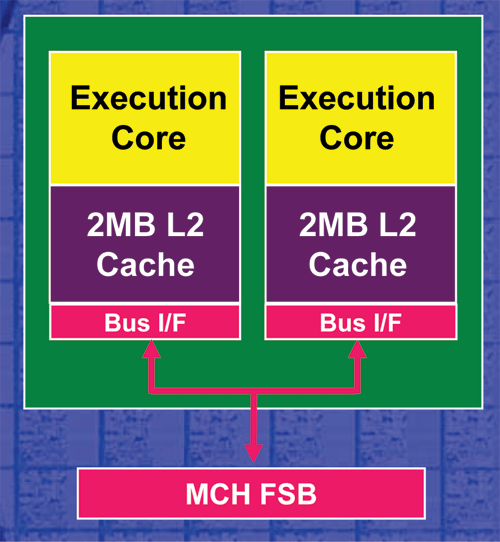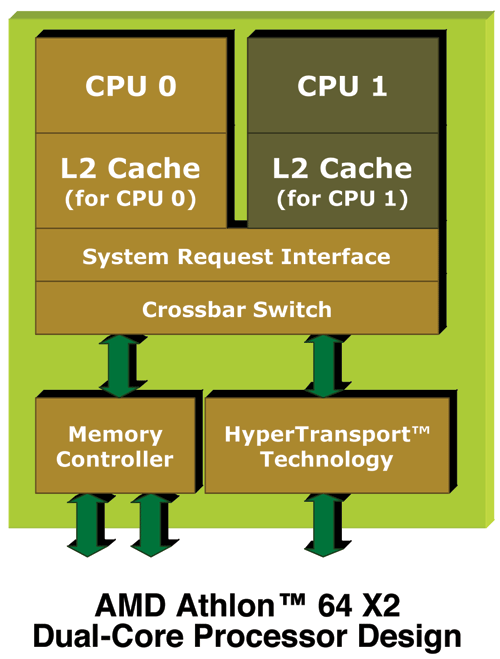AMD's dual core Opteron & Athlon 64 X2 - Server/Desktop Performance Preview
by Anand Lal Shimpi, Jason Clark & Ross Whitehead on April 21, 2005 9:25 AM EST- Posted in
- CPUs
A Look at AMD's Dual Core Architecture
Even Intel will admit that the architecture of the Pentium D is not the most desirable as is two Pentium 4 cores literally glued together. The two cores can barely be managed independently from a power consumption standpoint (they still share the same voltage and must run in the same power state) and all communication between cores must go over the external FSB. The diagram below should illustrate the latter point pretty well:
Intel's Pentium D dual core architecture
AMD's architecture is much more sophisticated, thanks to the K8 architecture's on-die North Bridge. While we normally only discuss the benefits of the K8's on-die memory controller, the on-die North Bridge is extremely important for dual core. Instead of having all communication between the cores go over an external FSB, each core will put its request on the System Request Queue (SRQ) and when resources are available, the request will be sent to the appropriate execution core - all without leaving the confines of the CPU's die. There are numerous benefits to AMD's implementation, and in heavily multithreaded/multitasking scenarios, it is possible for AMD to have a performance advantage over Intel just because of this implementation detail alone.

AMD's solution to the problem will come in the form of DDR2 and a new socket down the road, but for now there's no getting around the memory bandwidth limitations. Intel is actually in a better position from a memory bandwidth standpoint. At this point, their chipsets provide more memory bandwidth than what a single core needs with their dual channel DDR2-667 controller. The problem is that the Intel dual core CPUs still run on a 64-bit wide 800MHz FSB, which makes Intel's problem more of a FSB bandwidth limitation than a memory bandwidth limitation.
Backwards Compatibility
Intel's dual core Pentium D and Extreme Edition won't work in any previous motherboards, but as we mentioned at the start of this article, AMD has more bang. Here, the additional bang comes from the almost 100% backwards compatibility with single-core motherboards. We say "almost" because it's not totally perfect; here's the breakdown:- On the desktop, the Athlon 64 X2 series is fully compatible with all Socket-939 motherboards. All you need is a BIOS update and you're good to go.For desktop users, the ability to upgrade your current Socket-939 motherboards to support dual core in the future is a huge offer from AMD. While it may not please motherboard manufacturers to lengthen upgrade cycles like this, we have never seen a CPU manufacturer take care of their users like this before. Even during the Socket-A days when you didn't have to upgrade your motherboard, most users still did because of better chipsets. AMD's architectural decisions have made those days obsolete. The next generation of dual core processors will most likely need a new motherboard, but rest assured that you have a solid upgrade path if you have recently invested in a new Socket-939 desktop system or Socket-940.
- For workstations/servers, if you have a motherboard that supports the 90nm Opterons, then all you need is a BIOS update for dual core Opteron support. If the motherboard does not support 90nm Opterons then you are, unfortunately, out of luck.










144 Comments
View All Comments
Phlargo - Thursday, April 21, 2005 - link
Sounds like computing could change a lot in the next 6 months.I can't wait to get my hands on a dual core chip - that type of multitasking gaming performance is what I've been waiting for... 92% of unfettered performance during Doom3? That's unbelievable.
manno - Thursday, April 21, 2005 - link
Another thing to consider is that the 939, and 940 Dual Cores work with old mobos. so that saves upgraders ~$100 for the mobo (I have no clue what PD mobo's are going to cost) plus the cost of DDR2 ~$100 for 512MB, not true if you're going with the PD. So if you own a 939 a 2.8 PD will realy cost you ~$441, 3.0 -$516, 3.2 ~$730.Throw that out the window if you're starting from scratch however.
manno - Thursday, April 21, 2005 - link
Great review very detailed, I have one caveat, and I should preface it with the fact that I own 4 systems, and all of them have Athlon 64's or XP's.That being said your "Multitasking Scenario 2: File Compression" Seems to be misleading, and identifies the A64 as the processor of choice in the 2nd portion of the analysis.
Maybe I'm wrong but from what I understand with how the test was performed you archived the file, got the amount of time it took to archive the file "x" for instance, and then figured out how many emails got imported in time "x" now because some processors took longer to create the archive than others they had more time to import emails. so in order to make this data more reflective of the performance of each processor you need to divide the number of emails imported by "x", and get e/s. The modified graph should be
PD 3.2 =19124/5.08 or 3764.57 e/s
A64 X2 =21687/6.25 or 3469.92 e/s
PEE 3.2 =16875/6.65 or 2537.59 e/s
AFX 55 = 3800/5.88 or 646.26 e/s
These corrected numbers show that at least in this test the PD 3.2 is the winner by ~8%
-manno
Calin - Thursday, April 21, 2005 - link
At that prices, most of the users really won't need their current mainboards for new dual core processors. I would prefer to have lower priced single core than that prices on dual core.blckgrffn - Thursday, April 21, 2005 - link
We are talking about by this fall, folks. And a 90nm Dual core still uses LESS die than 2 2800+ put together because it is on a manufacturing smaller process, especially if they stick to a 512k cache which is obviously the sweet spot. By this fall I expect that we will see sub $200 dual cores from Intel to squeeze AMD on the desktop market. What is a real shame is that AMD doesn't have suffcient fabs to handle potential demand.For those of you who got all hot in your pants and said I can't buy a sub $200 dual core Intel right now, it is just as true that I can't buy one it all! ;P Chill!
PeteRoy - Thursday, April 21, 2005 - link
Impressive.josedawg - Thursday, April 21, 2005 - link
Am I mistaken in thinking that AMD was throwing out their desktop dualcore line (A64 X2) in 2006? What prompted their earlier release of them? Was it the demand for desktop dualcore, pressure from Intel stealing desktop dualcore market, or excellent manufacturing at the AMD plants?KeithDust2000 - Thursday, April 21, 2005 - link
blckgrffn, "so if they can't bring anything out under $200 I will probably have to go with Intel. Boo for that ;) "INTEL doesn´t have one under $200 either.
Jeff7181 - Thursday, April 21, 2005 - link
#14... all socket 939 motherboards will support the X2 with a BIOS upgdate.Zebo - Thursday, April 21, 2005 - link
#9 They'd have to release a 1.6 @ $240 to accurately compete with Intels slowness in Pentium D's starting at $241. Sorry not gonna happen. AMD not for budget shoppers anymore but those interested in performance. Want the best? Pay the price. Or substandard CPU at a discount?I can see a 1.8 for about $250 though however no way you're going to get into DC for less than $200.